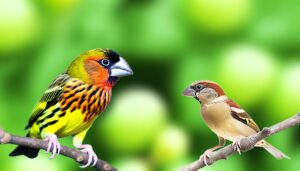5 Key Differences Between Female Finches and Sparrows
To distinguish female finches from sparrows, observe their plumage and beaks. Female finches exhibit uniform, subdued colors, and conical beaks designed for seed eating.
In contrast, female sparrows have earthy tones with pronounced streaking and longer, versatile beaks for a varied diet. Their vocalizations also differ: finches produce complex melodies, while sparrows emit simple, rhythmic chirps.
Habitat preferences vary too; finches adapt to diverse environments, whereas sparrows favor dense vegetation. Noticing these details helps clarify their differences and indicates there's more to explore about their unique behaviors and ecological roles.
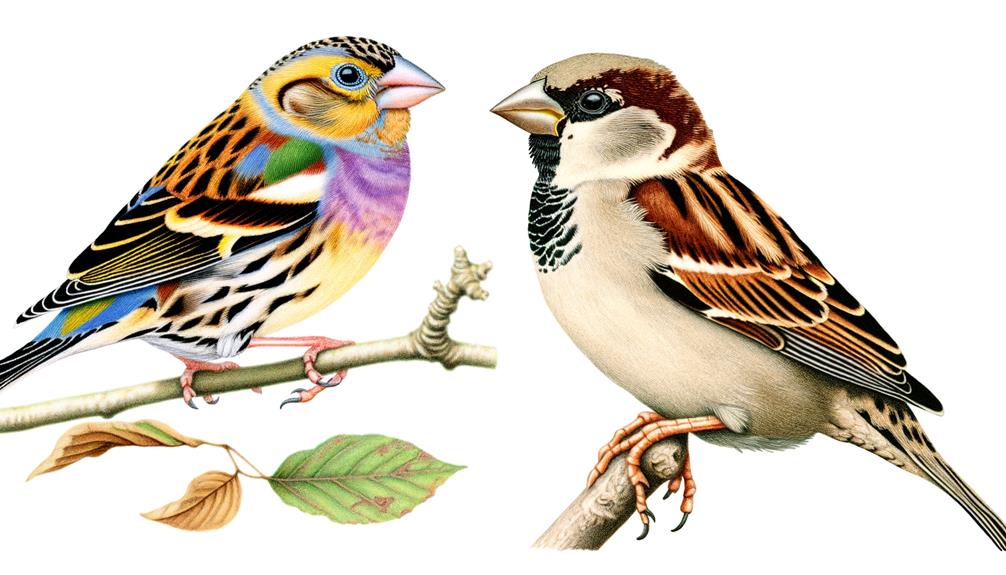
Key Takeaways
- Female finches have vibrant plumage, while female sparrows have earth-toned feathers for camouflage.
- Female finches have conical beaks for seed-eating; female sparrows have slender, versatile beaks for a varied diet.
- Female sparrows display pronounced streaking in their plumage; female finches have smoother, uniform coloration.
- Female finches produce melodious, intricate songs, whereas female sparrows emit simpler, repetitive chirps.
- Female finches are adaptable to various habitats, including urban areas; female sparrows prefer dense vegetation.
Physical Appearance
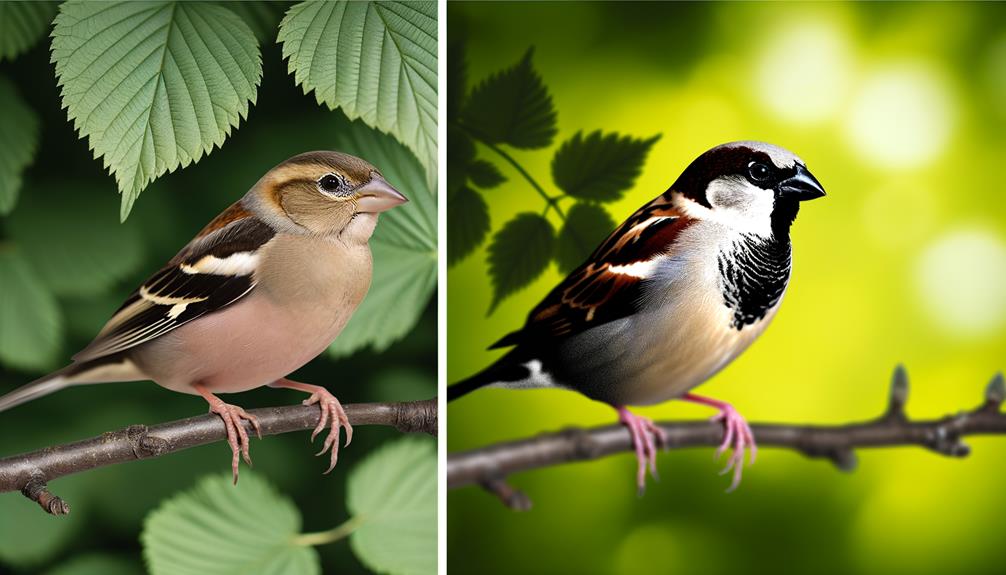
When examining the physical appearance of female finches and sparrows, you'll notice that finches generally exhibit more vibrant plumage, while sparrows tend to have more muted, earth-toned feathers.
Female finches often display a spectrum of colors, including yellows and reds, attributed to carotenoid pigments. In contrast, female sparrows typically showcase browns and grays, which serve as camouflage in their habitat.
Observing their beaks, finches have a more conical shape adapted for seed-eating, whereas sparrows possess slightly longer, pointed beaks suitable for a varied diet.
Additionally, finches are usually smaller and more compact, whereas sparrows have a more robust build. Understanding these differences can help you identify and appreciate these birds more accurately, enhancing your ability to serve and protect them.
Plumage Patterns
Examining the plumage patterns of female finches and sparrows reveals distinct differences in coloration and markings that can aid in species identification. Female finches generally exhibit a more uniform coloration, often in shades of brown and gray, with subtle streaking on their underparts. In contrast, female sparrows display more pronounced streaking across their chest and back, creating a more variegated appearance.
You'll notice that finches have a smoother, less contrasting pattern, while sparrows often show a mix of dark and light streaks that stand out. Pay attention to the wing bars: sparrows frequently have two distinct white wing bars, whereas finches' wing markings are less prominent. These plumage patterns are key in distinguishing these two species at a glance.
Beak Shape
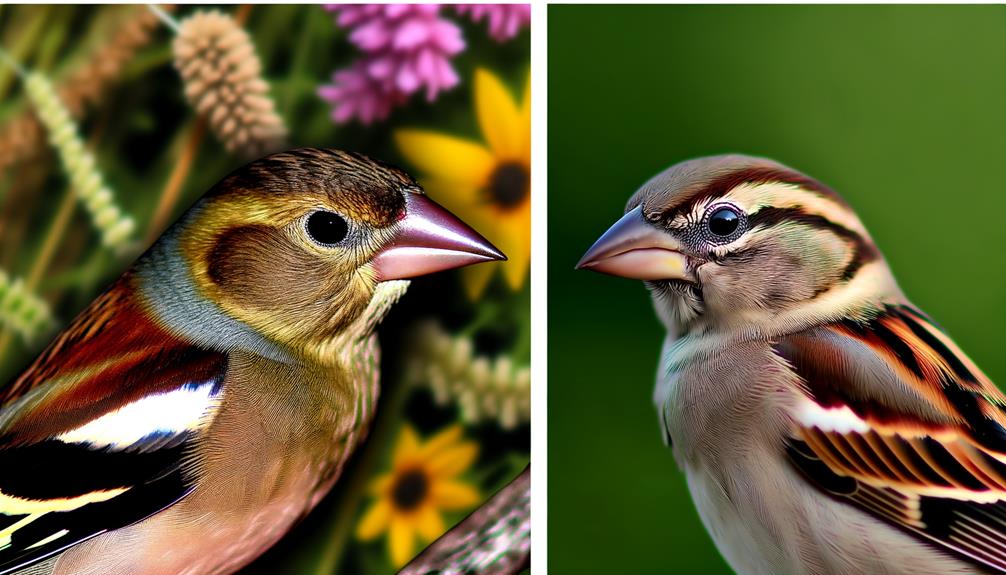
Observing the beak shape, you'll notice that female finches possess a more conical, robust beak designed for cracking seeds, whereas female sparrows feature a slightly more slender, versatile beak well-suited for a varied diet. The finch's beak is an adaptation for exerting significant pressure, ideal for seed predation. In contrast, the sparrow's beak is more generalized, allowing it to exploit a wider range of food sources, from seeds to insects.
| Feature | Female Finch Beak | Female Sparrow Beak |
|---|---|---|
| Shape | Conical | Slender |
| Primary Function | Cracking seeds | Diverse food consumption |
| Strength | Robust | Moderate |
| Adaptation | Specialized for seed predation | Generalized for varied diet |
| Efficiency | High for seeds | High for multiple food types |
This comparative analysis highlights the evolutionary adaptations that enable each bird to thrive in its respective ecological niche.
Vocalizations
You'll find that female finches and sparrows exhibit distinct vocalization patterns, with finches producing more melodious and intricate songs, while sparrows typically emit simpler, repetitive chirps.
Female finches often engage in elaborate vocal sequences, characterized by a range of pitches and tonal variations, which can be vital for courtship and territory defense.
In contrast, female sparrows' vocalizations are more straightforward, consisting of consistent, rhythmic chirps that serve as communication signals within their flock.
These vocal differences can greatly impact their social interactions and mating behaviors. Understanding these patterns helps you identify the species and appreciate their unique ecological roles.
Whether you're aiding in bird conservation or simply observing, recognizing these vocal traits enhances your ability to serve avian communities effectively.
Habitat Preferences
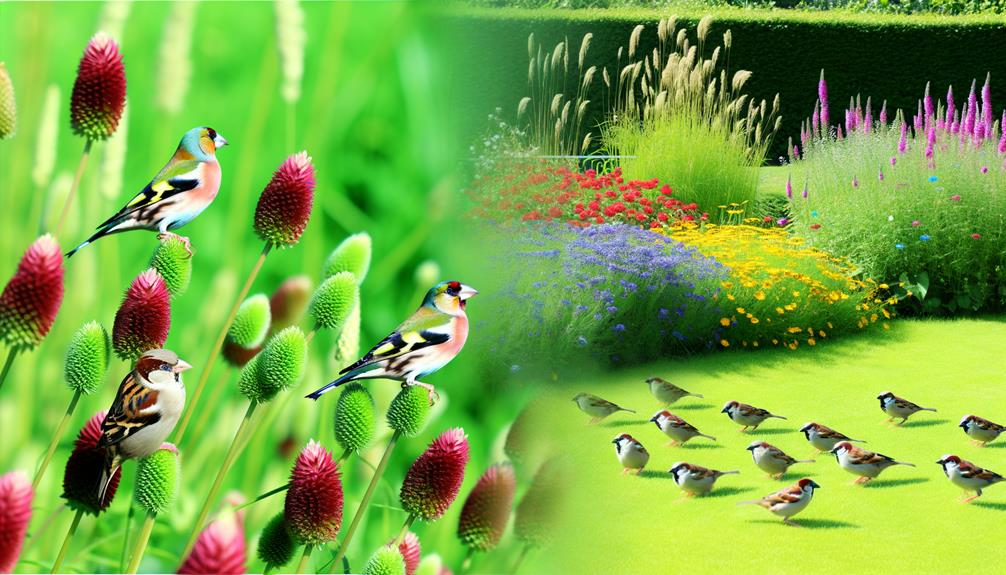
While appreciating the vocal distinctions, it's equally fascinating to compare the habitat preferences of female finches and sparrows, which greatly influence their behavior and ecological roles.
Female finches tend to favor diverse environments, from forests to grasslands, showcasing their adaptability. Often found in varying habitats, including urban areas, highlighting their versatility.
In contrast, female sparrows primarily inhabit areas with dense vegetation, reflecting their preference for ground foraging and nesting. Prefer shrublands and agricultural fields, emphasizing their reliance on thick cover for protection.
Consider these points:
- Female finches: Often found in varying habitats, including urban areas, highlighting their versatility.
- Female sparrows: Prefer shrublands and agricultural fields, emphasizing their reliance on thick cover for protection.
- Behavioral Influence: Habitat selection impacts nesting sites and food availability, shaping their survival strategies.
Conclusion
By closely observing physical appearance, plumage patterns, beak shape, vocalizations, and habitat preferences, you can distinguish female finches from sparrows.
Finches often display brighter plumage and conical beaks, while sparrows possess more subdued colors and rounded beaks. Their vocalizations also differ, with finches producing more melodic songs.
Habitually, finches favor varied environments, whereas sparrows lean towards more urban settings.
Understanding these nuances will enhance your birdwatching experience, revealing the rich tapestry of avian diversity right before your eyes.



